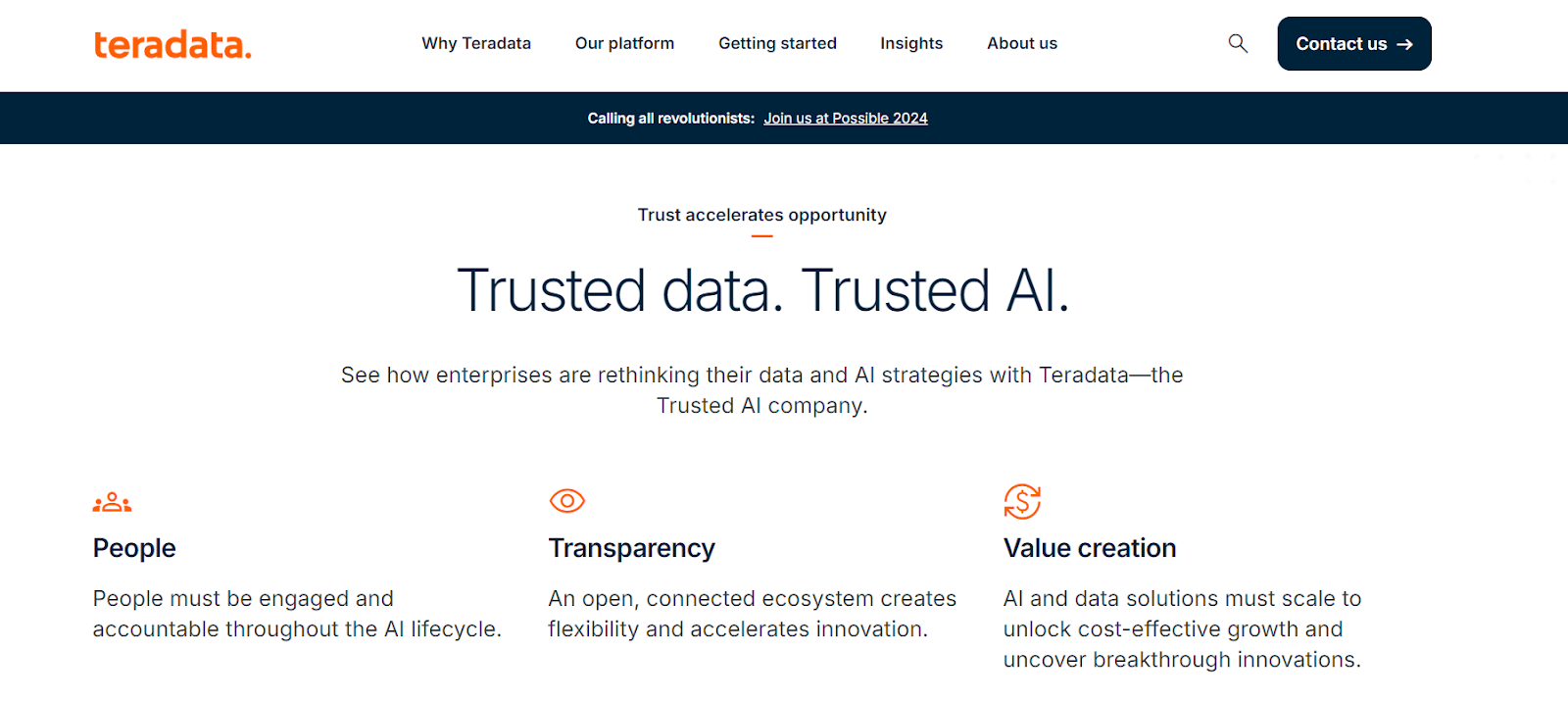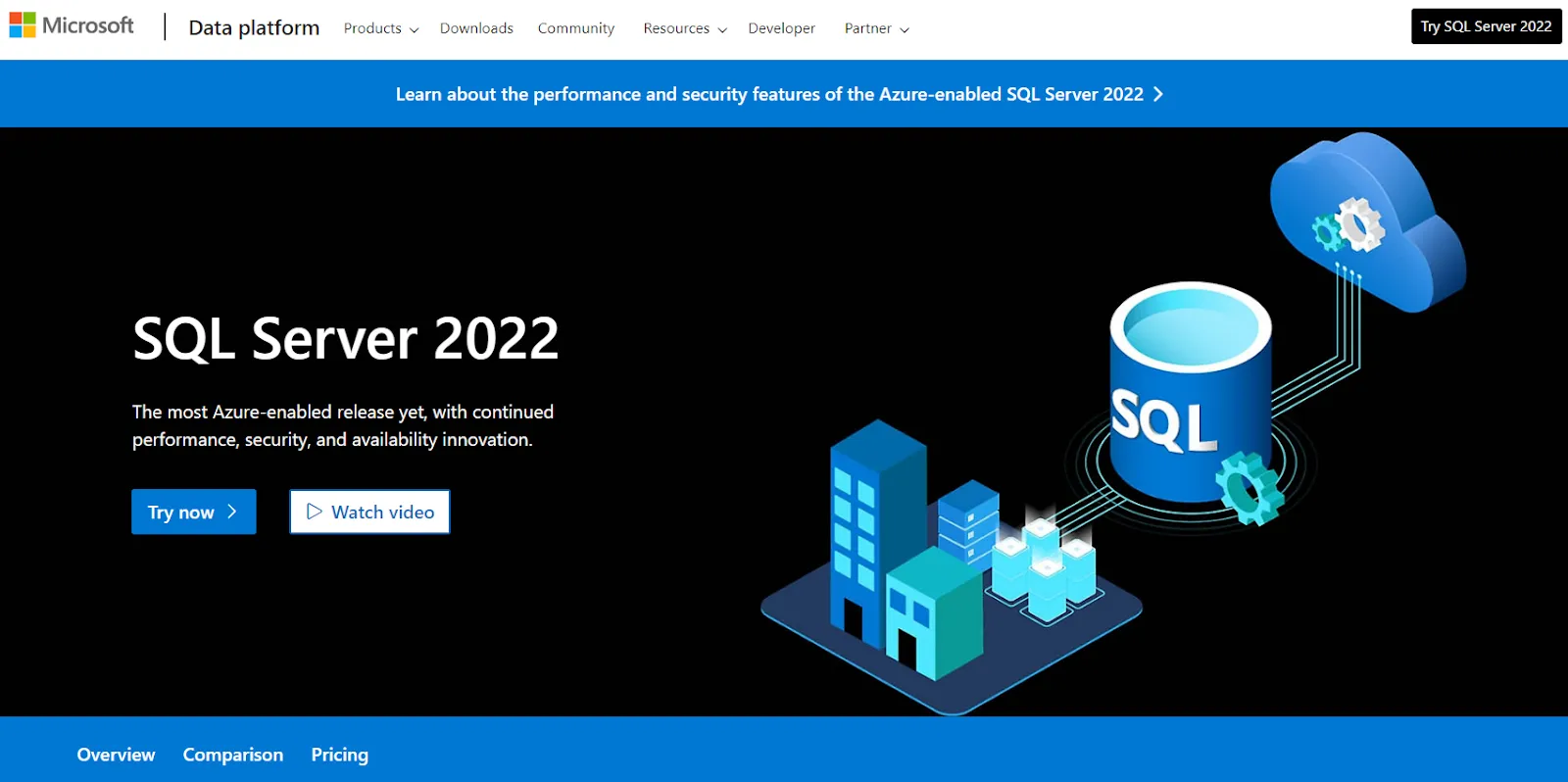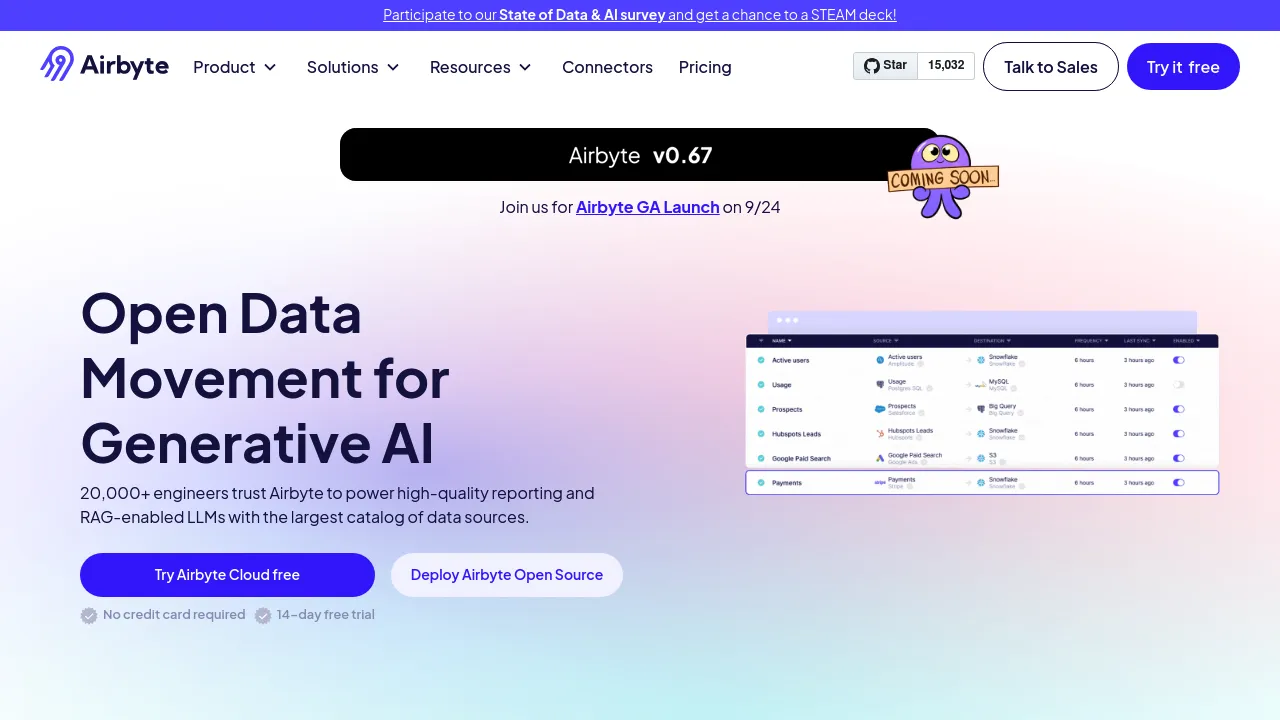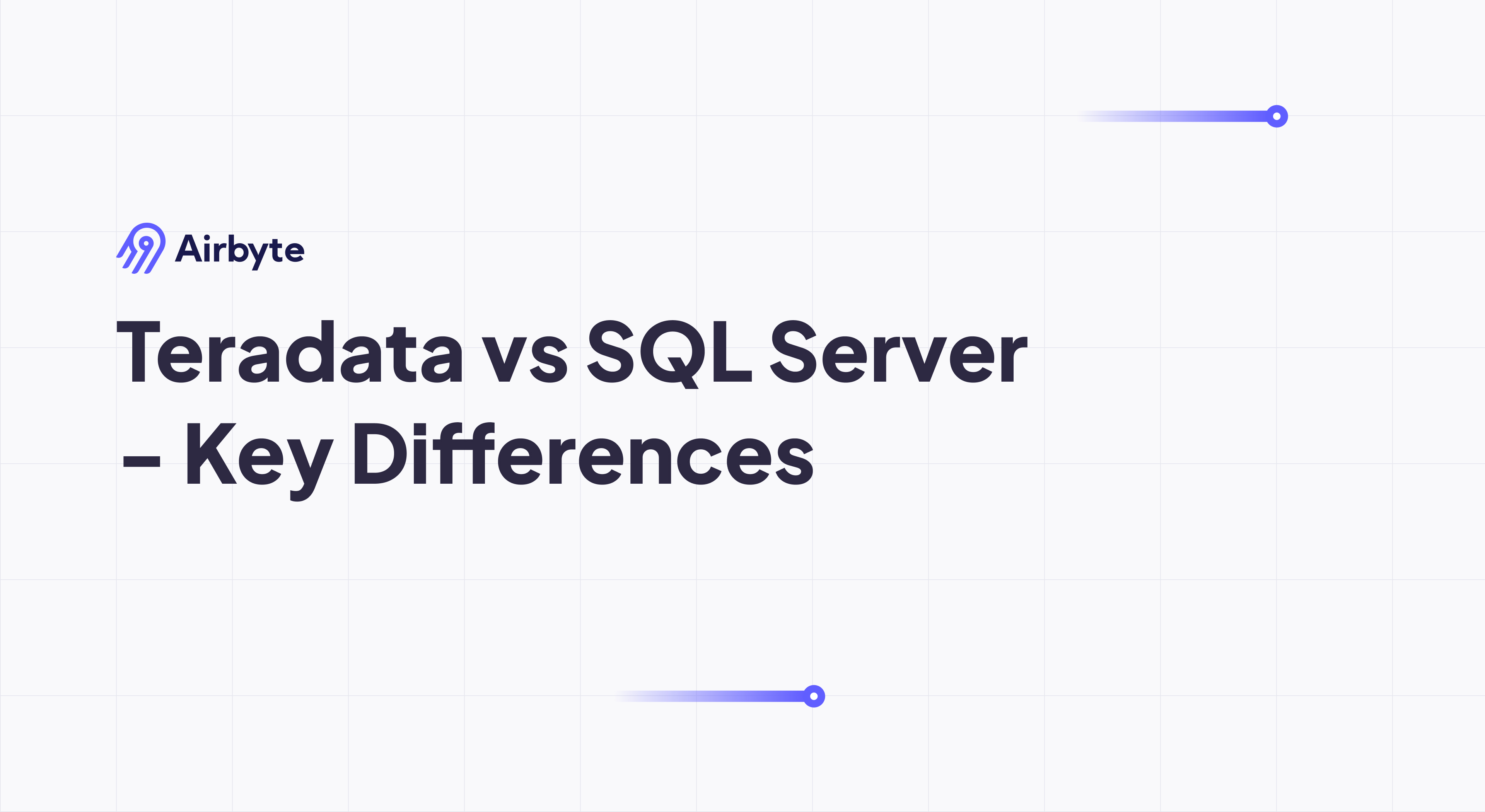Teradata vs SQL Server - Key Differences
Summarize this article with:
✨ AI Generated Summary
This comparison highlights key differences between Teradata and SQL Server for enterprise data management:
- Teradata excels in large-scale, multi-cloud analytics with MPP architecture, advanced AI integration, and consumption-based pricing.
- SQL Server offers strong transactional processing, deep Azure ecosystem integration, intelligent query optimization, and hybrid AI capabilities.
- Teradata supports federated, minimal-movement data integration across heterogeneous systems; SQL Server focuses on centralized Microsoft-centric pipelines.
- Security: Teradata emphasizes fine-grained access control and external key management; SQL Server advances zero-trust, secure enclaves, and Azure governance.
- Performance: Teradata uses partitioned indexes and multi-cluster execution; SQL Server employs adaptive query processing and batch-mode OLTP/analytics concurrency.
- Airbyte enables streamlined, secure data movement between Teradata and SQL Server with open-source, flexible connectors and schema management.
This comprehensive comparison examines Teradata vs. SQL Server to help you make informed decisions about your data-warehousing infrastructure.
By understanding the architectural differences, deployment options, and integration capabilities of these platforms, you can optimize your data operations for both current needs and future growth while avoiding vendor lock-in situations that constrain long-term technology evolution.
What Is Teradata and How Does It Function as an Enterprise Platform?
Teradata is a relational database management system (RDBMS) designed and developed by Teradata Corporation. Running on Linux, macOS, and Windows, it is a highly scalable solution that manages more than 50 petabytes of data. Teradata supports distributed data management and offers a parallel-aware optimizer to run your data tasks efficiently across massively parallel processing architectures.

Teradata's massively parallel processing (MPP) architecture enables the simultaneous execution of multiple queries across multiple nodes. It supports Online Analytical Processing (OLAP) and simplifies data management by centralizing control and providing a streamlined interface for database administrators. The shared-nothing design isolates compute resources, preventing workload interference, while BYNET facilitates high-speed inter-node communication for linear scalability across petabyte-scale datasets.
Recent innovations in Teradata VantageCloud include advanced AI integration through ClearScape Analytics with built-in algorithms for data preparation, model training, and evaluation. The platform now features real-time analytics for high-volume streaming data and introduces generative-AI tools such as ask.ai for natural-language queries, enabling non-technical users to generate SQL code and visualizations from conversational prompts. VantageCloud Lake represents a fundamental reengineering toward cloud-native architecture with compute separation models that enable dedicated resource allocation for varied workloads, from real-time transactions to AI model training.
Key Features of Teradata
- Shared-Nothing Architecture – Nodes, AMPs, and disks operate independently, ensuring uninterrupted performance across distributed environments.
- Active Data Warehousing (ADW) – Enables real-time data processing and analytics with subsecond response times.
- Security and Reliability – Auditing, monitoring, role-based access control, and network-traffic encryption with FIPS 140-2 compliance.
- Enhanced Connectivity – Connect to channel-attached systems, network-attached systems, or mainframes for data integration across hybrid environments.
- Low Total Cost of Ownership – Efficient resource utilization and scalability without additional hardware through consumption-based pricing.
- AI Unlimited – Serverless AI/ML engine supporting Apache Iceberg/Delta Lake formats and native Python/R execution for advanced analytics.
- QueryGrid Data Fabric – Multi-cloud data fabric connecting sources like Snowflake and Databricks for unified querying with zero-copy data sharing.
- ClearScape Analytics – End-to-end ML pipelines without data movement, enabling in-database machine learning with comprehensive model lifecycle management.
What Is SQL Server and How Does It Support Modern Enterprise Workloads?
SQL Server is a comprehensive RDBMS developed by Microsoft, known for its high performance and ease of use. It provides a robust environment for data management with features supporting complex transactions, business intelligence, and advanced analytics, and integrates seamlessly with other Microsoft products. The platform serves as both a transactional workhorse and an intelligent platform for hybrid AI and multi-cloud operations.

Its main components include a storage engine that manages database pages, files, tables, indexes, and data buffers, and a relational engine that processes queries. SQL Server delivers high availability whether deployed on-premises or in the cloud, with advanced capabilities that now extend beyond traditional transaction processing into real-time analytics and AI integration.
SQL Server 2022 and the upcoming 2025 release introduce transformative enhancements such as Parameter Sensitive Plan optimization, intelligent query processing, S3-compatible object-storage support for backups, and Azure Synapse Link for near-real-time analytics. The 2025 release represents a paradigm shift toward intelligent, real-time data ecosystems with native vector processing capabilities, deep learning integration, and Fabric synchronization that transforms the database into a unified operational and analytical platform.
Key Features of SQL Server
- In-Memory OLTP – Boosts performance by optimizing data access and transaction execution with intelligent memory management.
- Temporal Tables – Track data changes over time for historical analysis and auditing with automated versioning capabilities.
- Intelligent Database Capabilities – In-memory support, persistent-memory support, and in-memory-optimized
tempdbfor enhanced performance. - Improved Cardinality Estimation – Better query optimization with adaptive processing and Parameter Sensitive Plan caching for multiple execution strategies.
- Advanced Security – Transparent data encryption, dynamic data masking, monitoring, and auditing with blockchain-based ledger capabilities.
- Azure Synapse Link – Bidirectional replication between on-premises SQL Server and Azure SQL Managed Instance with near real-time synchronization.
- Machine Learning Services – Run Python/R scripts in-database for data preparation, feature engineering, and model scoring with ONNX integration.
- Hardware Acceleration – Intel QAT offloading and enhanced columnstore performance with GPU-accelerated inferencing support.
- Vector Database Engine – Native vector data types and approximate nearest neighbor searches for AI applications and semantic search.
What Are the Key Architectural and Functional Differences Between Teradata and SQL Server?
The main difference between Teradata and MS SQL Server is that Teradata is a data warehouse optimized for large-scale analytics and complex queries, while MS SQL Server is a relational database designed for transactional processing and enterprise applications.
How Do Deployment Flexibility and Cloud Strategies Compare Between the Platforms?
Teradata's Multi-Cloud and Hybrid Capabilities
Teradata VantageCloud runs as a fully managed service on AWS, Azure, and Google Cloud with portable licensing that lets organizations reallocate cores across environments without renegotiation. The platform demonstrates superior multi-cloud flexibility, avoiding vendor lock-in while maintaining consistent performance and governance across heterogeneous cloud environments. QueryGrid enables cross-environment analytics, and the Hybrid Data Pipeline exposes on-premises data through REST, JDBC, and ODBC without firewall changes.
VantageCloud Lake architecture introduces dynamic resource orchestration via smart-scaling technology, which autonomously provisions compute resources based on workload demands. This enables dedicated resource allocation for varied workloads, from real-time transactions to AI model training, while optimizing costs and maintaining performance SLAs. The platform supports automated continuous data ingestion from cloud-native object storage, reducing ETL latency for streaming analytics across distributed environments.
SQL Server's Azure-Centric Hybrid Model
SQL Server offers comprehensive deployment options within the Microsoft ecosystem:
- IaaS – Full control via Azure VMs with enhanced Arc management.
- PaaS – Azure SQL Database with automated management and intelligent optimization.
- Managed Instance – Near-full SQL Server compatibility as a service with failover capabilities.
Azure Arc extends Azure management to on-premises and multi-cloud SQL Server deployments, while the 2025 release embraces zero-ETL analytics through deep integration with Microsoft Fabric. The mirroring technology continuously replicates on-premises databases to Fabric OneLake in near real-time, creating automatically synchronized lakehouse counterparts that enable cross-write operations between analytical queries and operational systems.
Comparative Analysis
Teradata excels when multi-cloud portability and petabyte-scale analytics are paramount, particularly for organizations requiring cloud-agnostic flexibility and regulatory compliance across multiple jurisdictions. SQL Server shines in Microsoft-centric environments seeking tight Azure integration and cost optimization, with superior ecosystem synergies that simplify enterprise adoption through unified management and security policies.
What Are the Primary Data-Integration Approaches for Each Platform?
Teradata's Distributed Integration Framework
Teradata employs a distributed, federation-first approach that minimizes data movement while maximizing analytical capabilities across heterogeneous environments. QueryGrid federates queries across heterogeneous systems without data movement, enabling real-time cross-platform analytics. Data Mover automates object-level replication with intelligent scheduling and conflict resolution. The platform emphasizes ELT with in-database transformation via the Advanced Analytics Engine, supporting complex analytical workloads at scale.
The QueryGrid Data Fabric connects diverse sources like Snowflake, Databricks, and cloud storage through unified querying with zero-copy data sharing. This architecture enables organizations to maintain data sovereignty while accessing distributed analytical capabilities. Native Object Store interoperability allows frictionless data exchange between VantageCloud and third-party analytics engines like Spark and Presto, transforming the platform into a unified data fabric controller.
SQL Server's Centralized Integration Model
SQL Server prioritizes centralized orchestration through tightly integrated Microsoft ecosystem components. SQL Server Integration Services (SSIS) serves as the core ETL engine with enhanced Control Flow and Connection Managers for hybrid pipeline management. PolyBase enables T-SQL virtualization of external data sources with expanded support for Oracle, MongoDB, and ODBC connectors. Azure Data Factory and Azure Synapse Link provide cloud-native pipelines with intelligent automation.
The 2025 release introduces PolyBase V3 with enhanced pushdown capabilities for Databricks Delta Lake and Kusto queries, allowing single T-SQL statements to join on-premises data with Fabric-resident datasets. Data API Builder automatically generates REST and GraphQL endpoints for SQL Server tables, enabling modern application development patterns without middleware complexity.
How Do Security and Compliance Features Address Enterprise Requirements?
Teradata Security Evolution
Teradata has transformed from network-layer protections to comprehensive data-centric security models. VantageCloud Lake introduces column-level encryption via Thales CipherTrust, enabling customer-controlled encryption keys separate from cloud infrastructure through BYOE (Bring Your Own Encryption) models. This allows enterprises to enforce data sovereignty while maintaining analytical performance at scale.
Modern security enhancements include AES-256 encryption in transit, client-managed keys, and dynamic JWT key rotation for session management. Poly-anonymization combines tokenization, format-preserving encryption, and differential privacy for regulatory compliance. The platform maintains SOC 2 Type II and FedRAMP Moderate certifications while supporting HIPAA, PCI DSS, and industry-specific compliance frameworks. Role-based access controls now feature multi-level security roles with contextual filtering based on user, application, location, and time parameters.
SQL Server Security Transformation
SQL Server has evolved toward zero-trust architectures with mandatory security enhancements. The 2022 release mandated TLS 1.3 for all connections and introduced TDS 8.0, enforcing encryption before authentication to prevent man-in-the-middle vulnerabilities. The 2025 release replaces SHA-512 with PBKDF2 password hashing (100,000 iterations) to thwart brute-force attacks while adding OAEP padding support for certificates and asymmetric keys.
Always Encrypted with secure enclaves enables computations on encrypted data with enhanced performance through key caching and enclave multithreading. Ledger features provide blockchain-inspired immutable transaction histories for regulatory compliance. Azure Active Directory integration extends to Linux and Windows Arc-enabled servers, while Microsoft Purview delivers unified governance with centralized access policies that override database-specific permissions.
What Performance-Optimization Strategies Work Best for Each Platform?
Teradata Performance Excellence
Teradata optimization leverages its MPP architecture through intelligent resource management and automated performance tuning. Automated statistics collection via TASM (Teradata Active System Management) and Viewpoint provides continuous performance monitoring and adjustment. Thoughtful Primary-Index and Partitioned Primary-Index design becomes critical for optimal data distribution across nodes, while Intelligent Memory prioritizes hot datasets in RAM for enhanced query response times.
Multi-cluster execution enables complex queries to leverage parallel processing across multiple node clusters simultaneously. GPU acceleration through NVIDIA partnerships supports AI workloads and advanced analytics. The platform's workload-specific pricing tiers (Base/Advanced/Enterprise) include temporal indexing and row-level security optimizations. Elastic scaling allows on-demand compute adjustment without downtime, while ClearScape Analytics optimizes ML pipeline performance through in-database execution.
SQL Server Performance Innovation
SQL Server 2025 introduces revolutionary performance enhancements through its Cardinality Estimation Framework v5, which tracks multi-dimensional histogram correlations for improved complex join predictions. Intelligent Query Processing incorporates parameter-sensitivity optimization that caches multiple execution plans for parameterized queries, while Memory Grant Feedback dynamically adjusts allocation between iterations.
The Optimized Locking subsystem dynamically escalates row locks based on access patterns, reducing latching overhead significantly in OLTP benchmarks. Adaptive Indexing allows the query optimizer to automatically materialize transient indexes during execution, persisting them based on reuse patterns. For hybrid workloads, BATCHMODENO_DELAY enables concurrent OLTP and analytics without resource contention, while XML compression reduces storage overhead for document-centric workloads.
How Do Advanced Analytics and AI Integration Compare Between Platforms?
Teradata's AI Factory Ecosystem
Teradata's 2025 AI Factory launch targets regulated industries with pre-packaged compliance frameworks and NVIDIA GPU integration. The platform's Enterprise Vector Store enables hybrid AI workflows where embeddings coexist with relational data, supporting semantic search and Retrieval-Augmented Generation patterns. ClearScape Analytics provides comprehensive AI orchestration, supporting end-to-end ML pipelines without data movement while leveraging the MPP engine for horizontal scaling.
The Bring Your Own Model framework evolves into a comprehensive AI Factory ecosystem, supporting unified model registries for PMML, ONNX, and MOJO formats with automated versioning and A/B testing pipelines. Real-time model monitoring tracks concept drift, data drift, and prediction accuracy degradation, triggering automated retraining workflows. For large language models, collaboration with NVIDIA integrates NeMo Retriever microservices directly into VantageCloud Lake, enabling GPU-accelerated RAG pipelines that combine enterprise data with generative AI.
AI Unlimited platform expansion introduces AutoML pipelines with automated feature engineering, algorithm selection, and hyperparameter tuning optimized for Vantage's MPP architecture. The drag-and-drop MLOps interface within Vantage Analyst allows data scientists to deploy champion/challenger models without SQL coding, while the Unbounded Array Framework enables distributed execution of Python/R libraries across Teradata nodes for large-scale feature transformation.
SQL Server's Deep Learning Integration
SQL Server 2025 introduces deep learning as a first-class citizen through its integrated vector database engine. The native vector data type stores embeddings in DiskANN-optimized structures, while vector indexes enable approximate nearest neighbor searches at sub-second latency for billion-scale datasets. The spinvokeexternalrestendpoint function allows T-SQL to directly call Azure OpenAI, Hugging Face, or custom AI endpoints, embedding generative AI into stored procedures.
For on-premises deployments, SQL Server 2025 supports NVIDIA GPU-accelerated inferencing, allowing enterprises to run Llama-2 or Phi-2 models locally with tensor parallelism optimizations. Built-in text chunking algorithms and sentence transformers automate embedding generation for RAG implementations without external dependencies. Machine Learning Services support in-database Python/R/Java execution with RevoScaleR libraries, while Azure ML integration enables deployment of ONNX models via PREDICT T-SQL functions.
The platform's vector engine positions SQL Server as foundational for Microsoft Copilot integrations, enabling natural language querying of structured data. Parallel development focuses on Microsoft Fabric integration, creating an intelligence stack from database to business intelligence that supports contextual decision engines.
What Decision Factors Should Guide Your Platform Selection?
- Data Volume & Complexity – Teradata excels with massive, complex analytical datasets requiring linear scalability, while SQL Server optimizes for mixed transactional and analytical workloads with moderate complexity.
- Scalability & Performance – Teradata's MPP architecture scales linearly across petabyte datasets, whereas SQL Server provides intelligent optimization for diverse workload patterns with adaptive performance management.
- Infrastructure Integration – Teradata offers multi-cloud portability with vendor-agnostic flexibility, while SQL Server delivers seamless integration within Microsoft ecosystems through unified management and security.
- Advanced Analytics – Teradata's ClearScape Analytics provides comprehensive ML/AI orchestration with enterprise governance, versus SQL Server's embedded intelligence with vector processing and Fabric integration.
- Talent Availability – SQL Server benefits from a larger talent pool and community resources, while Teradata requires specialized expertise but offers comprehensive vendor support.
- Support & Community – Teradata provides enterprise-grade vendor support with industry-specific expertise, whereas SQL Server offers extensive community resources and Microsoft ecosystem integration.
- Use-Case Fit – Teradata targets large-scale data warehousing with regulatory compliance requirements, while SQL Server serves transactional systems requiring data integrity with analytical capabilities.
- Total Cost of Ownership – Teradata's consumption-based pricing with compute-storage decoupling versus SQL Server's competitive licensing with Azure ecosystem cost advantages.
How Can You Streamline Data Movement Between Teradata and SQL Server?
Airbyte provides an open-source, AI-powered approach to automate data pipelines between systems such as SQL Server and Teradata, eliminating the traditional trade-offs that force organizations to choose between expensive, inflexible proprietary solutions and complex, resource-intensive custom integrations.

Airbyte transforms data integration challenges by combining the flexibility developers demand with the governance and security enterprise leaders require. The platform generates open-standard code and offers deployment flexibility across cloud, hybrid, and on-premises environments while maintaining enterprise-grade security and compliance capabilities, supporting organizations moving from legacy ETL platforms to modern cloud-native architectures.
Key Airbyte Features
- 600+ Pre-built Connectors – Comprehensive connector library covering databases, APIs, files, and SaaS applications accessible through UI, API, Terraform, or PyAirbyte for Python developers.
- Schema-Change Management – Automatically detect and propagate schema changes without manual intervention, ensuring data pipeline reliability.
- Vector-Database Support – Load data into vector databases such as Pinecone, Qdrant, and Milvus for AI-powered applications.
- Enterprise Security – End-to-end data encryption, role-based access control, and comprehensive audit logging with SOC 2, GDPR, and HIPAA compliance.
- Multi-Deployment Flexibility – Cloud-native, hybrid, and on-premises deployments with consistent functionality across environments, avoiding vendor lock-in.
Conclusion
Teradata and SQL Server represent distinct approaches to enterprise data management, with Teradata excelling in massive-scale analytics and multi-cloud flexibility while SQL Server delivers superior Microsoft ecosystem integration. For organizations requiring data movement between these platforms, Airbyte offers a flexible solution that maintains data sovereignty while eliminating traditional integration trade-offs.
Frequently Asked Questions
1. What is the primary difference between Teradata and SQL Server?
Teradata is a large-scale analytics platform using MPP architecture for complex queries, while SQL Server is a general-purpose RDBMS optimized for OLTP and tightly integrated with Microsoft’s ecosystem, serving both transactional and moderate analytical workloads.
2. Which platform offers more deployment flexibility?
Teradata provides greater deployment flexibility with true multi-cloud and hybrid support across AWS, Azure, Google Cloud, and on-prem setups. SQL Server is optimized for Azure environments, making it best for Microsoft-focused ecosystems but less flexible overall.
3. How do Teradata and SQL Server differ in integration capabilities?
Teradata enables federated queries across heterogeneous systems with minimal data movement, supporting real-time ingestion and distributed ELT. SQL Server relies on SSIS and PolyBase for data integration, excelling in structured, Microsoft-centric environments but offering less cross-platform flexibility.
4. Which platform is stronger in security and compliance?
Teradata emphasizes fine-grained access control, external key management, and regulatory compliance, excelling in finance and healthcare. SQL Server focuses on secure enclaves, Always Encrypted, and Azure governance integration, ideal for Microsoft-centric environments requiring tight cloud alignment.
5. What are the key performance optimization strategies for each platform?
Teradata optimizes performance using partitioned primary indexes, multi-cluster execution, and TASM-managed statistics, excelling in petabyte-scale analytics. SQL Server leverages intelligent query processing, memory grant feedback, batch-mode execution, and automated index management, balancing OLTP and OLAP workloads efficiently.

.webp)
